There are approximately 2400 species of praying mantises on the planet. All of these species are well known for their voracious appetite and remarkable ability to hunt.
But, what exactly do praying mantis eat?
A praying mantis is carnivorous, a ferocious predator that feeds on insects like grasshoppers, crickets, spiders, butterflies, beetles, mites, roaches, aphids, flies, and at times other mantises. Praying mantis also preys on small animals such as frogs, turtles, rodents, lizards, even hummingbirds.
How is a mere insect able to prey on animals? It is a mystery. Keep on reading to discover their exceptional hunting skills, top-notch adaptations, how to feed them as pets, and much more.
Praying Mantis Diet
Praying mantises have a super expansive diet that satisfies their ravenous appetite. They are biotrophic, meaning they are both herbivorous and carnivorous and mostly feed on insects but also target arthropods such as spiders and even some small vertebrate animals.
Their ability to consume larger animals depends on their sizes. Those who grow up to a length of 10-12cm are the ones who can take on rodents and birds. Large mantises are known to feed on hummingbirds sunbirds, warblers, honeyeaters, vireos, and flycatchers. Reptiles that make for a superb meal for the ferocious insect include lizards, frogs, toads, turtles, and snakes.
Shockingly, the bloodthirsty pests are also famed for scooping goldfish out of fishbowls and feasting on them. The master predators have to access the prey size before making a move.
Praying mantises feed indiscriminately on harmful and beneficial insects and can be a nuisance or helpful to farmers. They also feed on moths at night, which helps to eradicate them in your home or garden. Amazingly, they are one of the main predators that feed on moths.
After eating, the praying mantis cleans the mouth and entire body with its forelegs to eliminate any possible remains of insects.
Yes, Female Mantises Feed On Their Mate
Most female mantises tend to eat their mates during the mating process or after copulation. This mode of feeding is referred to as sexual cannibalism. Surprisingly, if they notice a male is an ideal food source rather than a good mate, they l feed on him before he even gets a chance to mate, by biting off the male’s head.
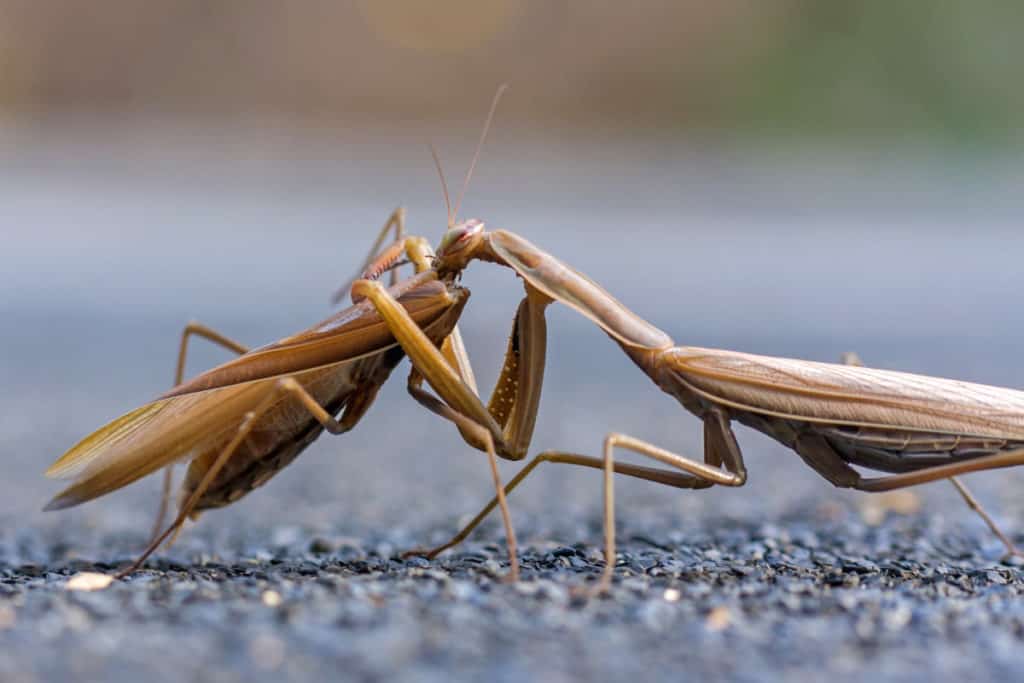
Some researchers argue that females with low-quality diets and limited food sources are more likely to feed on their mates. A high percentage of predatory mantis species are involved in sexual cannibalism.
Studies show that it may have an evolutionary benefit since the consumed male mantises pass on more genetic materials to the offspring. Newly hatched nymphs will also eat one another if they are confined in a place with limited food sources.
Do All Species Of Praying Mantises Feed On Insects?
While most praying mantises feed on insects, some species supplement their diet with pollen. They spend time on flowers not only to prey on bees and other pollinating insects but also to feed on pollen. This scenario mainly happens in the fall when there are limited sources of food and they find it hard to catch prey.
Pollen becomes their primary source of proteins when their preferred source in this case. Even if they rely mostly on excellent vision to search for a suitable food source, they also can detect released by the pollen.
What Do Nymphs Eat?
Praying mantises undergo incomplete metamorphosis. However, they go through several molting stages, which resemble wingless adults. Young mantises are born hungry so they start looking for food right away and feed on soft-bodied insects like aphids, which is a great way to get rid of them.
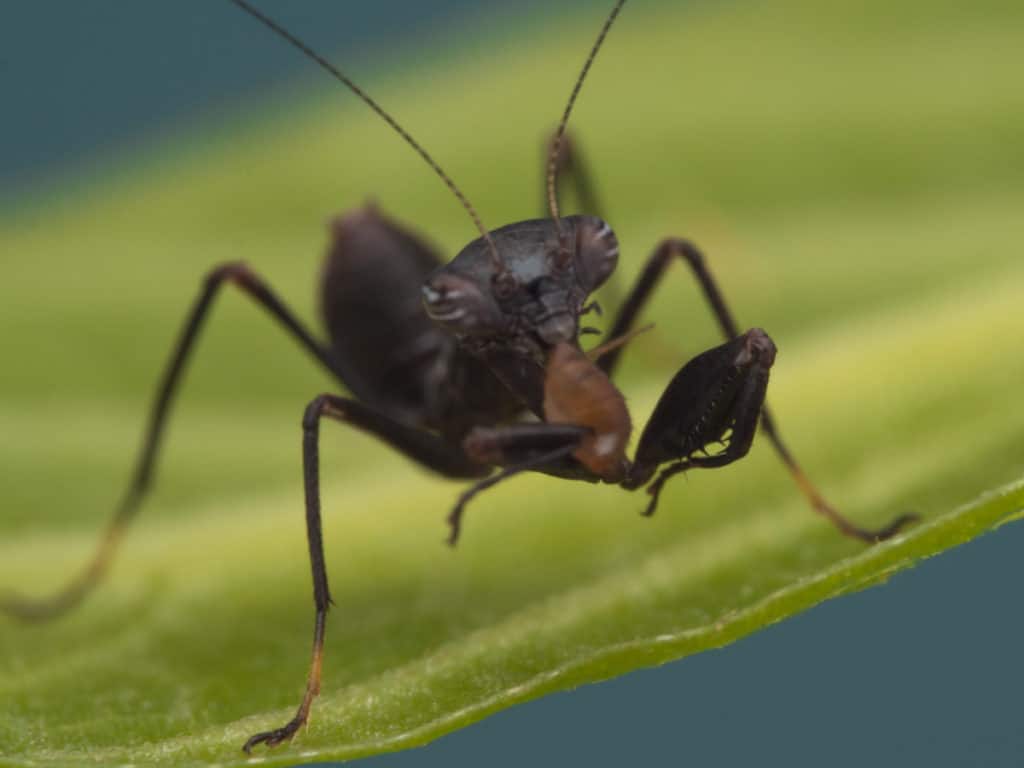
Nymph mantises also feed on gnats, leafhoppers, scale insects, and fruit flies. They will also cannibalize each other if they are confined in a small place with limited or no food.
Besides insects, they feed on pollen, which prevents them from starvation after hatching.
If you are interested we have written a whole article on what baby praying mantis eat. The article is called, What Do Baby Praying Mantis Eat?
Do Praying Mantises Drink Water?
Like other insects, mantises possess a tough exoskeleton that minimizes water loss from their bodies. Even so, they require drinking water regularly.
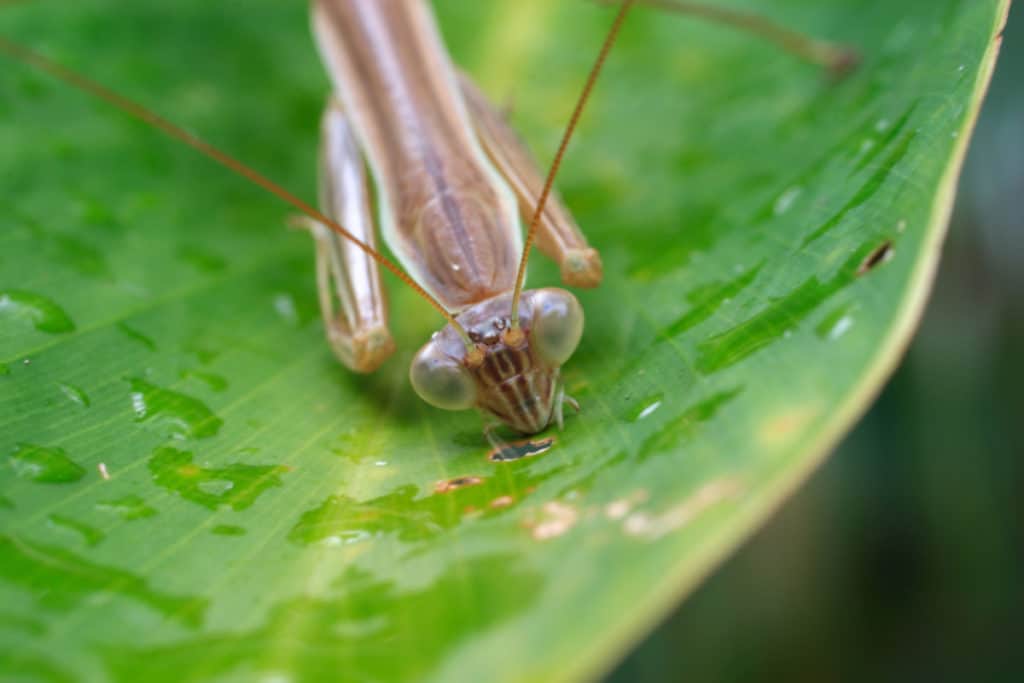
In their natural habitats, they drink water droplets left on leaves or plants after rain or dew. They also take water trapped at the base of leaves as well as some moisture from the prey they consume.
How Do Mantises Catch Prey?
You may be wondering how these incredible insects can prey on birds and rodents. Well, most of the mantises ambush predators. When prey is within reach, they strike swiftly, snapping it with their strong spiked legs.
Their reflexes show that they act two times quicker than a housefly. They are also quick to see with their eyes. The raptorial legs are armed with spikes for snaring the victims and pinning them in place as they enjoy their meal.
How Do Praying Mantises Hunt?
These sneaky insects hunt by waiting quietly for approaching prey or by stalking the hapless creatures with slow, stealthy movements. With their rare ability to rotate their head at 180 degrees and camouflage, praying mantises are master hunters. Although they are not able to jump as many insects do, they have no trouble catching the swift ones, thanks to their speedy reflexes and thorny raptorial forelegs.
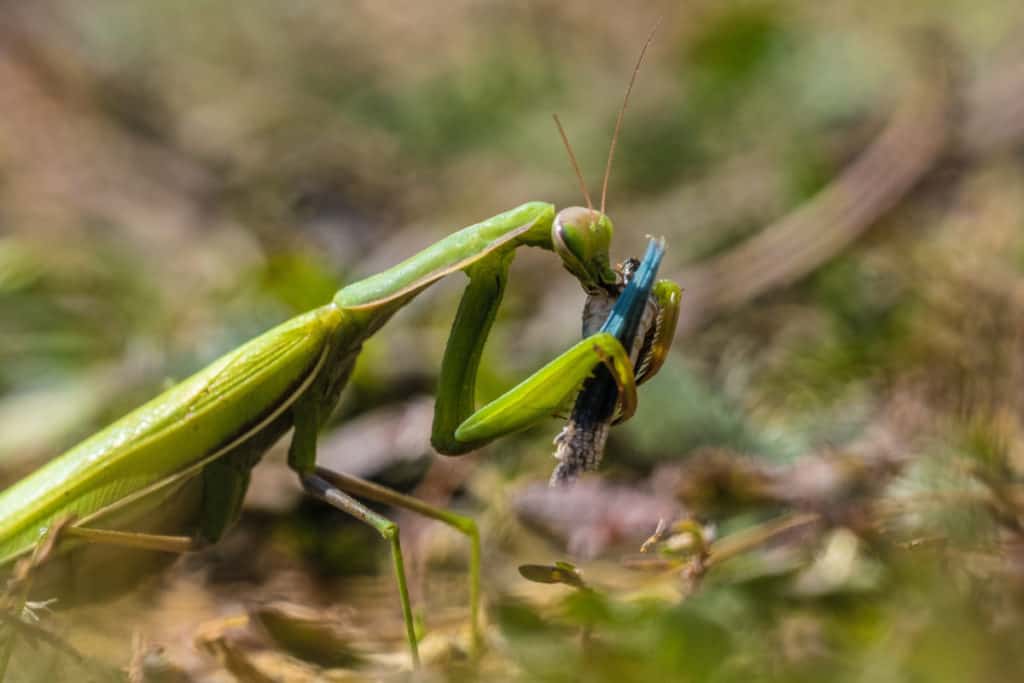
Once a victim is in their hands, the claws dig deep in the flesh or exoskeleton, making it impossible for them to escape.
There are a few exceptions though; some species of praying mantis such as Ligariella, Ligaria, and Entella chase their prey as mammals do. They resemble tiger beetles. Others possess extended guts, which act as a pantry to store food for digestion later. This storage is quite useful for insects that feed intermittently.
Thankfully, they do not harm people and rarely bite people unless threatened or provoked.
Say with us as we breakdown the physical features and abilities of pray mantis’ that make them the ultimate hunters.
Why Praying Mantis Are the Ultimate Hunters
Praying mantis have several physical features that come together to make them one of the most efficient hunters in the insect world. These features are:
- Swivel Head
- Excellent Eyesight
- Prominent Front Legs
- Mandibles
- Long Thorax
- Ability To Camouflage
- Agility
1. Swivel Head
Mantises turn their triangular-shaped heads 180 degrees to look over their shoulders like a human being. The flexibility helps the skilled predators to scan around their surroundings well. They can keep an eye on the predators as well as their prey.
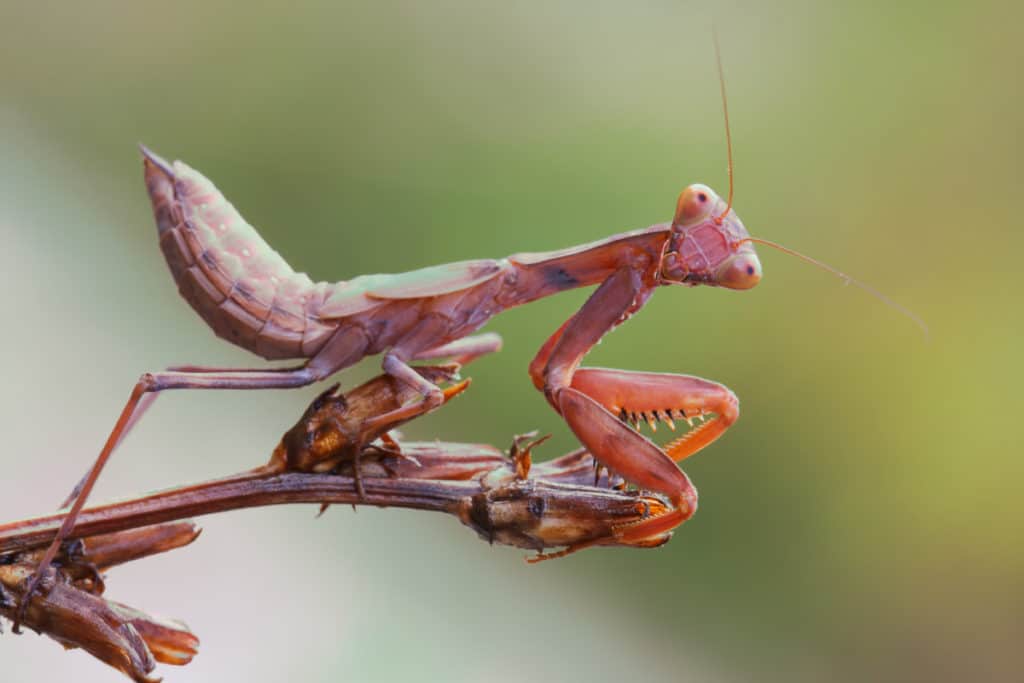
2. Excellent Eyesight
Their triangular heads boast two bulging compound eyes and three simple eyes. This is similar to that of bees and wasps. These are very crucial since they hunt primarily by sight. They use stereopsis, the ability to see objects in three dimensions through comparing images between two eyes. On noticing a prey, they track it by fixing their eyes on it before striking. The wide field of vision allows them to see colors, images, and movements that are invisible to naked human eyes.
When a target is in their visual field, they use their two compound eyes to triangulate and extract the size and position just like humans. They are capable of detecting the slightest movements from a distance of 60 feet away. The simple eyes are arranged in a triangle between the antennae, and they help to distinguish light and dark.
3. Prominent Front Legs
They are also known as the raptorial leg, which means they enhance the grasping of prey. The legs are armed with tooth-like spines and spikes that they use to lash out at the catch. Some species have about 30 spikes, which give them an extra hold of food, while most have only a handful.
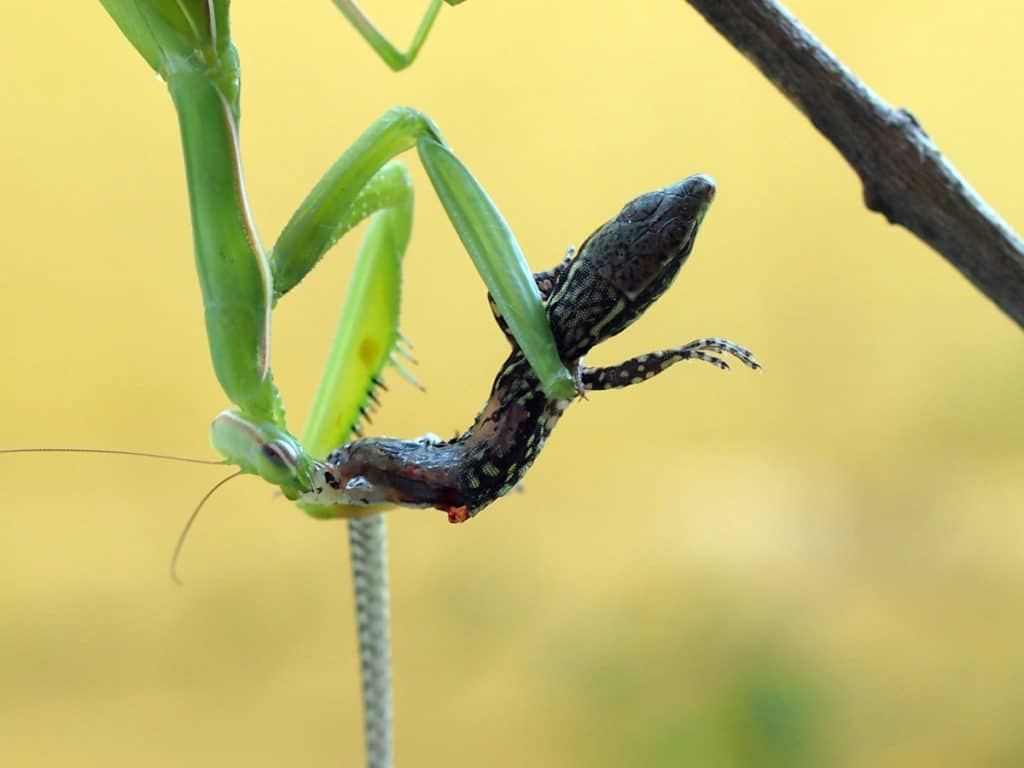
It takes only 50 to 70 milliseconds to snatch the victim from the air, six times faster than a blink of the eye. The forelegs are also helpful in grasping other things apart from food, especially when jumping from one branch or twig to another. The legs are adapted to reach out. If a prey gets too close, the legs cannot help them.
4. Mandibles
Praying mantises possess long and broad mandibles that are designed to tear off their prey. They are sharp and strong enough to rip off their prey’s skin or exoskeleton and cut into small pieces for digestion. The right mandible has two molars and two sharp incisors, while the left has four varying incisors.
In the middle of the incisors and molars of the right mandible, lies an acute cutter plate connected to the right incisor and left molar. The molar lobe of the left mandible has two large and one small tooth. The sharp cutter plate connects the right molar with the left incisor. All these ensure the food is properly chewed.
If you are interested we have an article we much more detail specifically about the mandibles of praying mantis. The article is called, Do Praying Mantis Bite?
5. Long Thorax
The mantis has a long thorax, which makes it look like an insect has a long neck. The prothorax is flexible and helps the mantis to move its head and forelegs without moving the rest parts of the body. It is especially vital since the forelimbs are their principal method of hunting.
6. Ability To Camouflage
By camouflaging, they can hide from their prey as well as predators. Most of them are green or brown, which helps them to blend well with leaves, branches, and sticks.
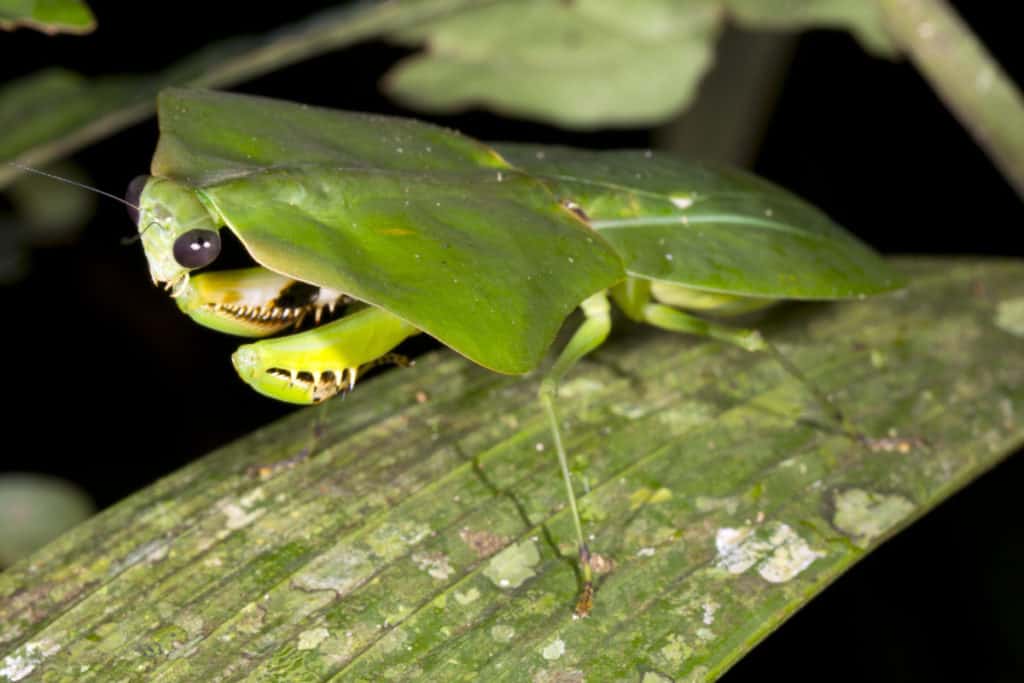
Some flower mantises are fancily decorated to mix with orchid petals. Insects coming to collect nectar fall into their trap and become a meal.
Since most of them are ambush hunters, they stand still for a long time waiting for prey. Some species have flat bodies, which limits their shadows cast in the sun, making it even harder to see them. Others change colors, molting with the seasons. They molt towards the end of a dry season to blend well with the blackened landscape and scorched trees.
7. Agility
The master predators are agile, like cats. They jump with acute precision, warping their body mid-flight, to land on a specific target.
Their agility not only helps them hunt but also helps to dodge attacks from predators once the are spotted.
What Do Praying Mantis Eat In Captivity?
Regardless of their intimidating appearance and brutal feeding patterns, praying mantises are kept as pets in various parts of the world. They cope well in captivity and don’t require large spaces. Raising a healthy praying mantis means balancing their diet to ensure they are well fed.
Food
Unlike other pets, such as dogs or cats, you do not have to feed the mantises daily. While their diet depends on the size of the mantis, you can supply them with food every two to four days.
The larger the mantis, the heftier the prey should be. They usually start with small insects and gradually turn to larger ones as they grow, such as crickets, blue bottle flies, and cockroaches. Young mantises usually feed on flies and mosquitoes.
To feed your mantis you can trap insects and release them into your pet’s container. You can also purchase their food online, in places where they sell insect and reptile food. It’s worth noting that they exclusively feed on alive insects. The mantis’ food should not be bigger than the mantis.
On the other side, if the insect is too tiny, it will be difficult for the mantis to grasp it. Alternatively, you can offer the food directly to the mantis with tweezers.
Hydration
The mantis also needs water while in captivity. You can supply it to them by placing a small wet sponge gently in the container every week. They usually collect the water from the sponge. You can also spray a mist of water on the cage weekly with a houseplant spray gun, depending on the humidity.
The mantis house should be cleaned regularly by removing the dead insects from it. Cleaning is done with long forceps to limit disturbance to the mantis. An ideal cage should contain a wide-mouth jar covered with a screen or net on top and a plant branch in it.
If the vessel requires a thorough cleaning, you should remove the mantis gently and place it in a clean, spare container, with the branch as you clean it. Worth noting is that they are very delicate to handle. Sometimes they may strike out although their bites or scratches are not harmful to people.
Where Are You Likely To See Praying Mantises?
Praying mantises can easily adapt to various habitats. Most species dwell in tropical rainforests, even though others dwell in grasslands, deserts, and Meadowlands.
Females lay eggs, which overwinters and hatch in spring. Nymphs go through several stages before reaching the adult stage.
They are many types of mantises which are named after various regions of the world. Examples include Chinese Mantis, Carolina Mantis, Giant Asian Mantis, and European Mantis.
When Do Praying Mantis Feed Or Hunt?
Being mainly diurnal, praying mantises are mostly active during the day. However, the males are more active at night as some of their key predators are birds, so it is safer to feed at night.
They have a unique organ that detects echolocation calls of bats, which helps them to escape before they are consumed.
Praying Mantis Predators
It is hard to imagine the master predator becoming prey itself. However, many enemies enjoy having the praying mantis as their supper. These include bats, frogs, larger birds, large spiders, snakes, ants, hornets, and monkeys. Unfortunately, mantises have no venom or bitter-tasting chemical. They only rely on the mandibles and their spiny forelegs.
They can also work on scaring enemies away by putting on a terrifying look or making a hissing sound by pushing air through abdominal spiracles. Fire ants are a terrible predator to mantises; they cannot even protect themselves against even one ant, let alone a dozen. They bite the poor creature and discharge paralyzing venom before devouring it into pieces.
Mantises also prey on each other, especially during the nymph stage or during mating, and when no other food source is available.
Are Praying Mantises Beneficial To Farmers?
In some cases, these master predators may be beneficial to farmers seeking biological pest control agents. However, they do not specialize in a single pest and are general predators. They do not multiply rapidly to respond to pest infestations.
Unfortunately, they feed indiscriminately on both beneficial and harmful pests and may end up being more of a nuisance than offering help. In conclusion, they have negligible value in biological pest control.
The Wrap Up
Praying mantis are fantastic insects with an unusual shape, praying posture, voracious appetite, and numerous beneficial aspects. Although they are not harmful to human beings, it is a deadly killers in the insect world. Not only do they prey on insects but also small-sized reptiles and birds.
The mantises, including nymphs, can feed on each other when food sources are scarce. The female mantises engage in a higher level of cannibalism where they eat their mates during copulation.
If you are interested we have a bunch of other articles on the eating habits of other bugs. Check out the links below:
What Do Spiders Eat? (Their Fascinating Diets Revealed)
Vulture Bees: There Are Meat Eating Bees And They Make Honey
What Do Bees Eat? Their Complete Diet Revealed.
Sources
https://animals.howstuffworks.com/insects/praying-mantis.htm
https://gizmodo.com/why-female-praying-mantises-devour-their-partners-durin-1782818376
https://en.wikipedia.org/wiki/Mantis
https://academic.oup.com/ee/article/32/4/881/358658
https://www.treehugger.com/wondrous-facts-about-praying-mantises-4858807
